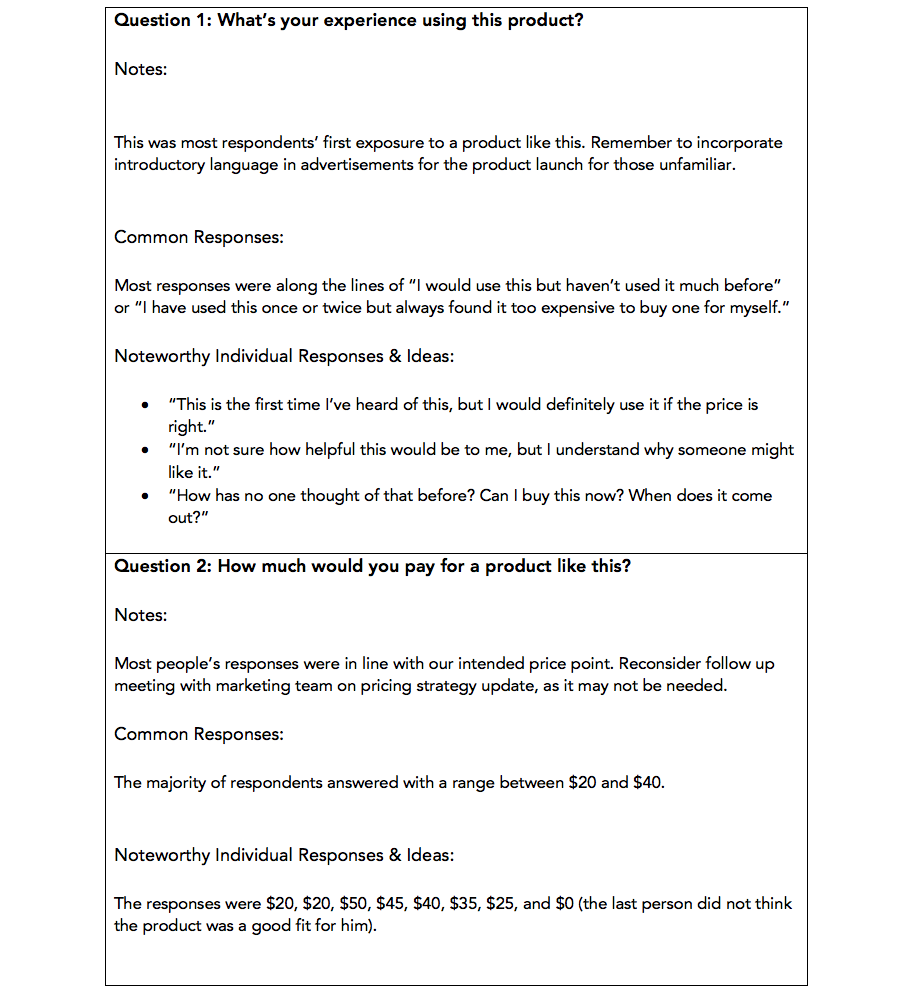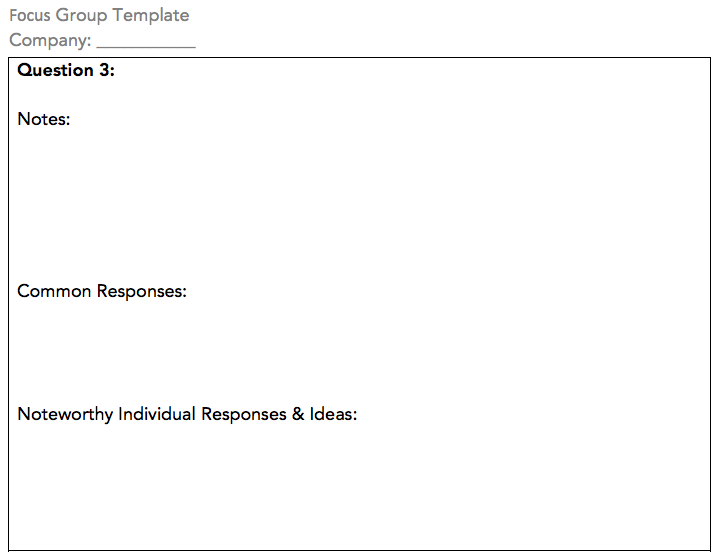When you're developing or launching a new product, service, or business, you'll want to have a general sense of how receptive your target market will be to it.
Typically, this is done through extensive market research -- and one key component of the market research process is running a focus group.
A focus group is a small group of people, typically representative of your target market, that you run ideas and questions about your product, service, or business by. The ideal outcome is a stronger understanding of how the subject of the focus group would be received by a wider audience, and what changes (if any) should be made before the formal roll-out.
In this article, we'll highlight a step-by-step process for running a focus group, from planning your focus group questions in a focus group questionnaire to incorporating the findings into your launch strategy.
Follow Along With a Free Focus Group Questionnaire Template

HubSpot's Market Research Kit includes everything you need to run an effective round of market research, including a focus group questionnaire and a guide on how to run focus groups. Download the kit now to incorporate the steps in this post into your focus group strategy.
How to Run a Focus Group
1. Choose your topic of discussion.
Going into a focus group, your discussion should be narrowed down to one or a few topics. Keep in mind that you won't be able to thoroughly address every area you want to discuss in one short focus group session.
Because of this, it's not uncommon for companies to run multiple rounds of focus groups around different topics. For example, if you're launching a new product, you could center one focus group around the product's marketing and brand positioning, and another one around the usability and functionality of the product itself.
2. Choose your questions or discussion prompts.
Once you determine the area of focus for your focus group, create a list of questions and discussion prompts that will help you gather the data you need.
Let's return to the product launch example from above. If you're running the product marketing focus groups, you could ask questions like:
- What do you think of the packaging design?
- How much money would you spend on a product like this?
- What other companies do you think of when you see a product like this?
Meanwhile, for the focus group about the product itself, you might want to go in with discussion prompts to ask about the product's:
- Functionality
- Ease of use
- Perceived favorability
Also, remember to ask open-ended questions -- "Do you like the product?" versus "What do you think of the product?" may seem similar in nature, but will likely produce dramatically different results.
3. Prepare your focus group questionnaire.
After you've chosen your questions and discussion prompts, organize them on a focus group questionnaire. Be sure to leave enough space on the questionnaire for overall notes, a list of common responses, and one or two noteworthy responses that really stood out.

Download this Template for Free
4. Appoint a notetaker.
Your focus group discussion should be facilitated by at least one person, while another person on your team should be a designated notetaker.
Why? The facilitator's job is to facilitate -- to guide the discussion and foster new ideas from participants. This task can get easily derailed if the facilitator also needs to pause the discussion to write down big, bold ideas and reactions from participants.
To avoid this possibility of disruption, appoint a notetaker before going into the focus group who can focus solely on jotting down the general consensus from the group, unique and noteworthy individual responses, and the key takeaways for the business.
5. Recruit and schedule participants.
One of the most challenging parts of running a focus group is getting people to actually show up. After you select a time and a place, you'll want to start spreading the word of the group to get participants.
Here are a few ways to find them:
1. Reach out to existing customers.
If you're doing market research for an existing company, reach out to your customers through account managers or an email database. Since current customers will likely be the first to use what you're launching, this will be the perfect opportunity to gauge early reactions for its ultimate launch.
For incentives, you could offer free or discounted services or reward them on a customer advocacy program like Influitive.
2. Advertise on social media.
Looking for middle-aged males or senior citizens in the greater Ann Arbor area? No problem! Social media advertising offers advanced targeting options for you to reach your target market.
You should also think about which sites are most used by the people you want in your focus group. If you're interested in surveying middle-aged working professionals, you'll probably have better luck on LinkedIn over Snapchat.
3. Try location-based promotion.
If you're hyper-targeting a location, supplement your recruiting efforts with advertisements that will only be seen by those in your area. A few examples include:
- Billboard Ads
- Public Transit-Based Ads (Trains, Busses, Taxis, etc.)
- Ads in Local Publications and Newspapers
4. Be prepared to offer incentives.
Unfortunately, people rarely do anything for free. In your advertisements and promotional assets, highlight the inventive you're prepared to offer -- which could be cash, a gift card, or a discount on whatever you're selling.
If you're scrapped for cash, consider hosting a raffle for participants. That way, if you host a focus group of eight people, you could offer a chance at a $100 gift card (rather than a guaranteed $25 per participant) to save you $100.
6. Get consent and start the discussion.
Before you start your focus group discussion, remind participants of the purpose of the group and hand out a consent form. The consent form should reiterate the purpose of the event, outline the participants' rights, identify the compensation, list the facilitators' contact information, and prompt participants to sign.
After everyone signs off, it's time to run the focus group.
7. Have everyone introduce themselves.
To break the ice and get people talking, start the discussion off by introducing yourself and inviting the participants to do the same.
This is another chance for you to learn more about your target market. In addition to having participants say their names, consider asking them to share their industry or interests to get a more personal understanding of how your product, service, or business could play a role in their everyday lives.
8. Ask your questions.
Start by asking your list of five to 10 prepared questions.
Going into the focus group, it can be easy to tie yourself to your list of questions or discussion points, but sticking too closely to this can hamper natural and effective conversations. If the group takes a slightly different turn that you were expecting, don't be afraid to allow the conversation to veer off-course from your questions if it seems productive.
The point of a focus group is not just to confirm information you think is true, but also to uncover what you don't know.
So long as it's not too far off-topic, allow the conversation to happen naturally and use the discussion prompts as a guide rather than a point-by-point checklist of topics to cover.
Additionally, your list of questions may not all be asked, depending on the direction of the conversation. Make sure you ask the more important questions first, and follow-up on certain discussion points with the right next question to keep things flowing rather than hosting a pure question-and-answer forum.
9. Seek equal representation from the group.
Remember, this is not an interview! You're running a focus group to solicit multiple ideas, and only hearing from one or two people defeats the purpose of the exercise. Be ready to jump in when someone has been quiet for too long and say something along the lines of "Julie, what's your input here?" or "Michael, what do you think about what Julie said?"
10. End the meeting in a reasonable amount of time.
Exhaustion and the law of diminishing returns are real, so keep them in mind when planning the time frame for your focus group.
At the start of the focus group, in your advertisements, and/or on your consent form, you should specify a range of how long the focus group will last. It's your responsibility to moderate the discussion in a way that ensures that time frame is not exceeded.
Now, if the exercise lasts for an hour and five minutes and you promised an hour focus group, that's totally acceptable. However, if you promised a 45 minute session and it goes well over an hour, your attendees could be resentful and less likely to offer valuable feedback.
When the discussion is over, thank your attendees for their time and feedback and deliver the promised incentive, if applicable. Additionally, remind them of your contact information if they decide they have more feedback or comments they'd like to provide.
11. Analyze and incorporate feedback.
Ideally, your focus group has provided you with plenty of responses, unique angles, and actionable ideas to help your business thrive. After all of your focus groups have taken place, have your team compile and analyze the commonalities of the ideas presented and what changes, if any, they warrant to the product, service, or business in question.
Running a Better Focus Group
Taking this methodical approach to running a focus group can produce better and more insightful feedback from your participants. To keep your questions, thoughts, and responses organized, we developed a focus group template, which you can use to run a better focus group.
Download it for free now to make your marketing research worth the effort.
from Marketing https://ift.tt/30e86w7
via
No comments:
Post a Comment